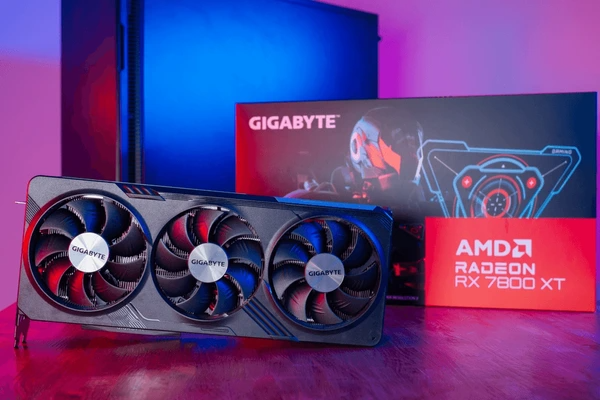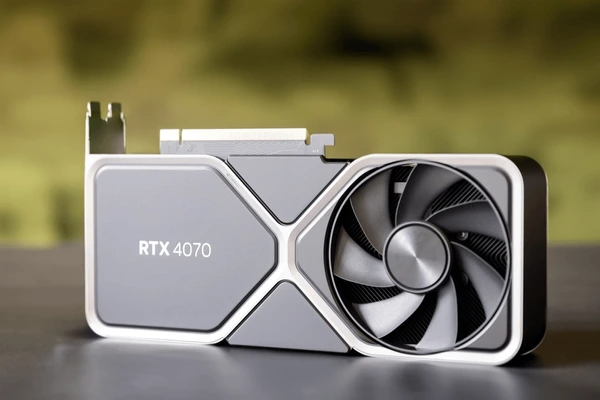
Introduction
The battle between AMD’s 7800 XT and NVIDIA‘s 4070 is heating up, offering gamers and professionals powerful options for high-end graphics performance. This article will dive into the differences between the 7800 XT and 4070, examining their specifications, performance benchmarks, value proposition, and real-world use cases. Whether you’re building a gaming rig, a workstation, or considering an upgrade, understanding the nuances of these GPUs will help you make an informed decision.

Specifications: AMD 7800 XT vs. NVIDIA 4070
Understanding the technical differences between these two GPUs is crucial for any user. Let’s break down their key specs.
| Specification | AMD 7800 XT | NVIDIA 4070 |
|---|---|---|
| Architecture | RDNA 3 | Ada Lovelace |
| Core Count | 3840 Stream Processors | 5888 CUDA Cores |
| Memory | 16 GB GDDR6 | 12 GB GDDR6X |
| Base Clock | 2200 MHz | 1920 MHz |
| Boost Clock | 2500 MHz | 2475 MHz |
| Memory Bandwidth | 512 GB/s | 504 GB/s |
| TDP | 300W | 200W |
| Ray Tracing | Hardware-based RT support with RDNA 3 | Enhanced RT cores with DLSS 3.0 |
Both GPUs utilize cutting-edge architectures, with AMD using RDNA 3 and NVIDIA adopting the Ada Lovelace platform, which emphasizes efficiency and power in the latest graphics cards.
💡 When comparing the specifications of the AMD 7800 XT vs. NVIDIA 4070, Eureka Technical Q&A offers a comprehensive breakdown of key features like GPU architecture, clock speeds, and performance benchmarks, helping you make a data-driven choice based on your specific gaming or computing needs.
Key Differences Between 7800 XT and 4070
Although both cards aim at delivering premium performance, there are significant differences that could sway your decision.
- Performance Benchmarks
When it comes to raw power, the 7800 XT offers a higher amount of VRAM (16GB vs. 12GB), which may be beneficial for 4K gaming or heavy workloads like video editing. However, the 4070’s Ada Lovelace architecture provides superior per-clock performance, with a more efficient use of energy. - Benchmark Results
- In 1440p and 4K gaming, the 7800 XT consistently outperforms the 4070 in titles such as Cyberpunk 2077 and Far Cry 6 when ray tracing is disabled.
- However, the 4070 shows better results in ray tracing-intensive titles like Control and Shadow of the Tomb Raider, thanks to its superior RT cores and DLSS 3.0.
- Power Efficiency
The 4070 leads in power efficiency with a TDP of just 200W compared to the 7800 XT’s 300W. This makes the 4070 a more suitable option for users who want to minimize their power consumption, especially in multi-GPU setups. - Ray Tracing and AI Features
AMD has made strides in ray tracing with RDNA 3, but NVIDIA’s proprietary DLSS 3.0 technology gives it an edge in improving frame rates and image quality in supported games. The 4070’s advanced AI capabilities and dedicated RT cores enhance performance in games that use ray tracing effects, offering smoother gameplay at higher settings.
Pros and Cons of the 7800 XT and 4070
To provide a clearer picture, let’s look at the advantages and disadvantages of each GPU.
AMD 7800 XT Pros:
- More VRAM (16GB) – Beneficial for 4K gaming and future-proofing against VRAM-heavy applications.
- Better Raw Performance in Certain Titles – Outperforms in non-ray-traced, rasterized games.
- Cost – Generally priced more competitively than the 4070.
AMD 7800 XT Cons:
- Higher Power Draw – Consumes more power, requiring a more robust PSU.
- Ray Tracing Performance – While solid, it can’t match the 4070 in ray-traced games due to NVIDIA’s superior RT core design.
NVIDIA 4070 Pros:
- Ray Tracing and DLSS 3.0 – Superior in titles utilizing advanced ray tracing and AI upscaling, providing better overall image quality.
- Better Power Efficiency – Lower TDP makes it more energy-efficient and easier to integrate into builds.
- CUDA and Software Ecosystem – Widely supported by software for creators, researchers, and developers, thanks to NVIDIA’s CUDA cores.

NVIDIA 4070 Cons:
- Less VRAM – 12GB may limit the 4070’s future-proofing, especially in highly demanding applications and 4K gaming.
- Price – The 4070 tends to be priced higher than its competitors in the same range, leading to less value for the performance in some cases.
Cost Considerations and Value for Money
When considering the price, the 7800 XT offers a strong value proposition with its higher VRAM and competitive performance. The 4070, on the other hand, can justify its higher cost through superior ray tracing capabilities, DLSS 3.0 support, and lower power consumption.
- AMD 7800 XT: Priced typically around $600–$650, making it a solid option for gamers and professionals who need a GPU for high-end gaming without the extra cost of ray tracing.
- NVIDIA 4070: Generally priced around $700–$750, offering excellent ray tracing and AI performance but coming at a premium price.
Real-World Use Cases: When to Choose the 7800 XT or 4070
- Gaming at 1440p and 4K: The 7800 XT is great for 1440p gaming and excels in performance-heavy games without ray tracing. For high-refresh-rate 4K gaming, the 4070 holds an advantage with better handling of ray tracing effects.
- Content Creation: For workloads like 3D rendering and video editing, both GPUs perform well, but the 4070’s superior software ecosystem and power efficiency make it more appealing to professionals.
- Power-Conscious Builds: If you’re building a system with limited power budget or looking to keep power consumption down, the 4070’s 200W TDP is a standout feature.
Conclusion
Choosing between the 7800 XT and 4070 depends on your specific needs and use cases. If you’re looking for higher VRAM and raw performance for non-ray-traced gaming, the 7800 XT offers better value. However, if you prioritize ray tracing, DLSS 3.0, and better power efficiency, the 4070 is the better choice, especially for those who demand the best in visual quality and AI-enhanced gaming.
Both GPUs are powerful in their own right, so consider your budget, gaming preferences, and power constraints before making a final decision.
To get detailed scientific explanations of 7800 XT vs. 4070, try Patsnap Eureka.


